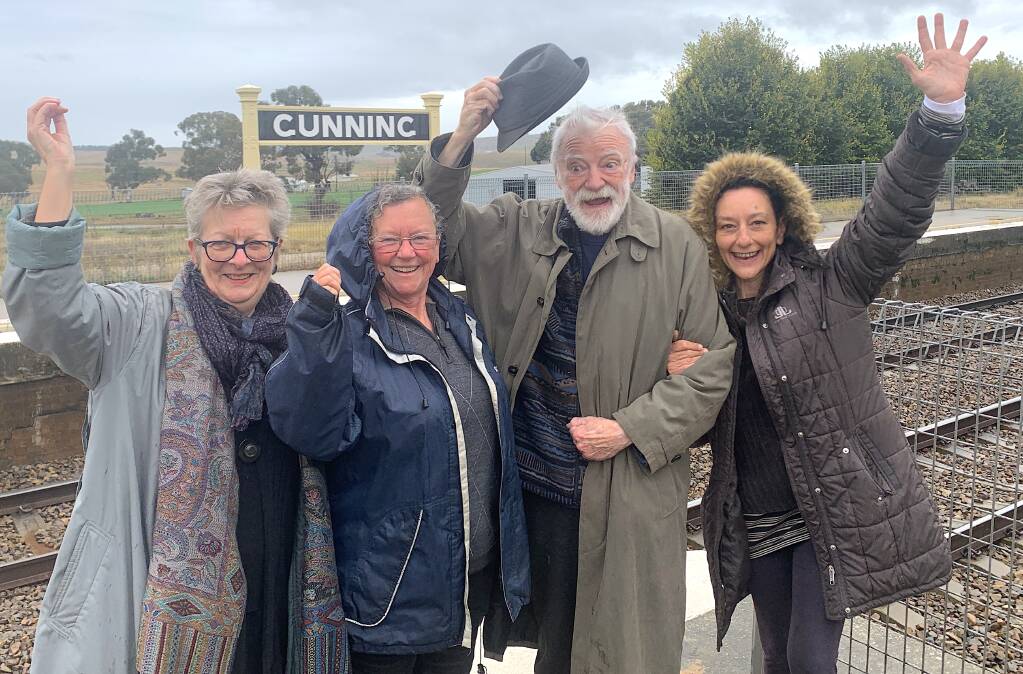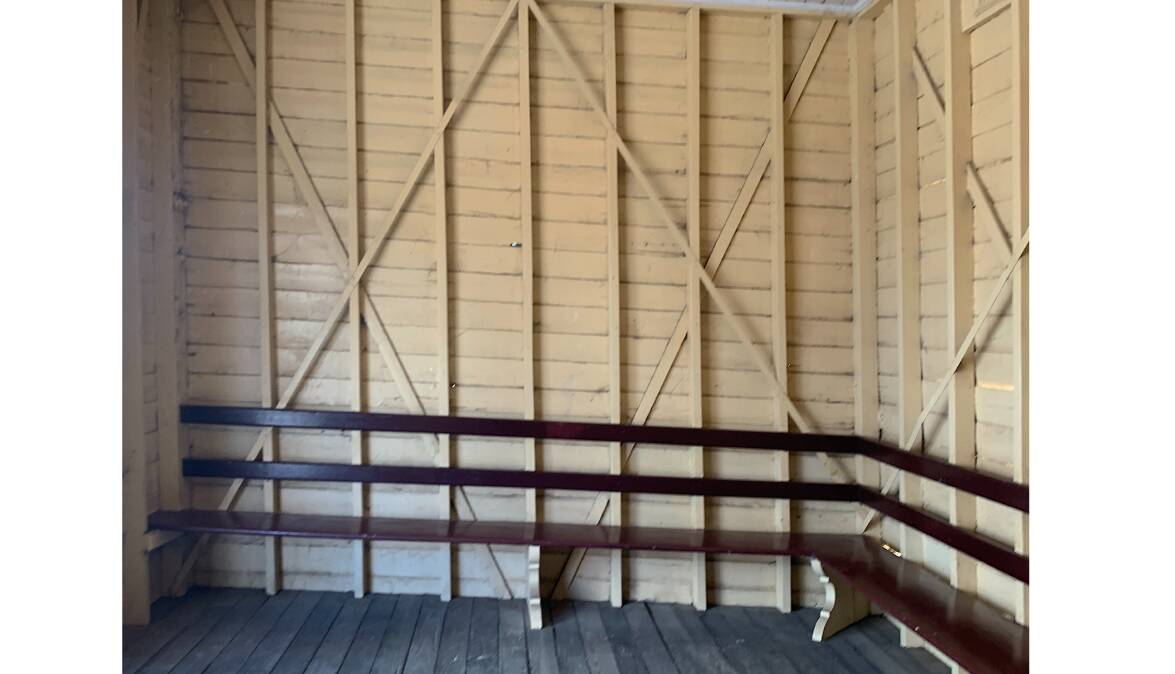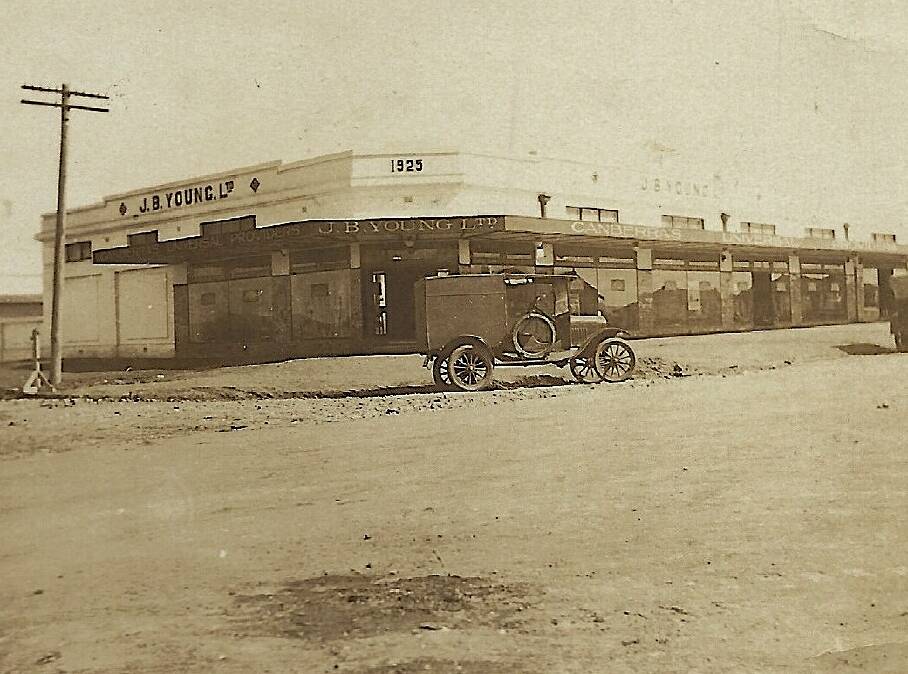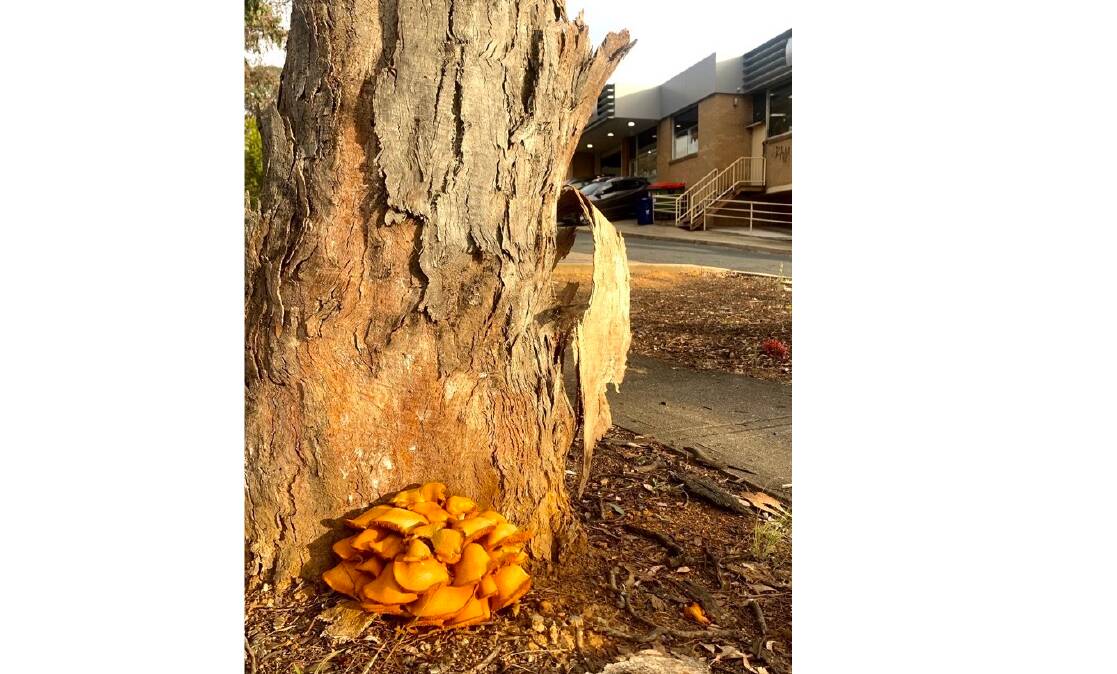
There's a long-running joke out Gunning way that the standalone wooden waiting room on the northbound platform at the town's railway station leans precipitously on an angle due to a century of howling gales.
Despite being one of the windiest places in NSW, the icy winter southerlies aren't responsible for the shelter's striking slant. Apparently, it's just old and in desperate need of some TLC, just like all most of the station's other circa 1910 buildings.
While the right-angle challenged waiting room and other buildings on the northbound platform will have to wait until later this year for a facelift, the renovation of the Victorian era clutch of structures on the station's southbound platform is almost complete.
And they've been spruced up with much more than just a lick of paint; the platform now re-purposed into a modern art hub, for community group Southern Tablelands Arts (STA).
Two years ago, Transport for NSW embarked on the ambitious restoration program of the station's buildings, many of which had been locked-up for over three decades.

"They hadn't been used since 1989 when the last station master turned the key and walked out", reveals Andrew Killingsworth, Residual Assets Programs Manager, Transport for NSW who is overseeing the project.
While supporters of other long neglected stations in the NSW rail network are crying out for similar funding, restoration is a costly exercise and although Killingsworth won't reveal the budget for the Gunning station overhaul, he does admit "we can't restore all stations, but we are very happy about this one."
"We're conscious there is a very lively arts and cultural scene emerging in Gunning, so this is a good fit", he explains.
The significant role the station has played in Gunning's past since it first opened in 1875 is not lost on Killingsworth. "In the late 19th and early 20th century, much of the town was based around the station including the former Frankfield Hotel (now a private residence) which serviced and provided accommodation to travellers and the nearby Railway Store", he explains.
"However, it's now a station in transition, it's moving away from its railway industrial past into a new culturally community focused future".

Earlier this week, while Killingsworth and his team of tradies were putting the finishing touches on the restoration, I braved the wet and windy conditions for a sneak peek.
"The sub surface was replaced due to termites, floorboards repaired, chimneys cleaned and capped, smashed windows fixed and walls cleaned " explains Killingsworth as he leads me in the first building, the old Parcels Office, warning me not to touch the freshly painted walls.
Bending down to check-out if the wooden benches beside the fireplace are original, I inadvertently lean up against the wall. Oops, you can't say I wasn't warned.
While the buildings are mostly being repurposed into art workshop and gallery spaces, Transport for NSW are also planning a few not-so-subtle nods to the building's original purpose.
"We're working on a small cabinet of curiosities featuring some old railway artefacts, and we might even insert a hologram in here to show what it once looked like" reveals Killingsworth, peering through the tiny glass ticketing window in the booking office.
"There's huge affection for railway stations, the architecture and history of the place", he explains, adding "if only the walls could talk - you had people who went off to war here, and of course, good yards transporting the area's famous wool clip".

As a working station (there are still a couple of passenger trains a day) the amenities, including the unique "modesty passage" which permitted ladies to walk directly from their own waiting room to the toilet (sorry, powder room) without having to venture outside, are also enjoying a welcome facelift.
Meanwhile, a small yard outside Porters Room is earmarked for a sculpture garden. Heck, what railway station can boast that?
"Other refurbished rooms will be used for workshops and classes", reveals Michelle Storey, a spokesperson for STA who "can't wait to bring the station to life again".
"Imagine hoping off the train and straight into a workshop or class" she attests.
Another local bursting with pride at the rebirth of the station is iconic Australian actor Max Cullen who has called Gunning home for the last 20 years.
"For so long, while waiting for the afternoon train to Sydney I've looked across at the forlorn buildings, thinking what a waste, wondering why they can't be utilised in some way", he reflects.

Next Saturday there will be a celebration of the rebirth of the station, and of course Cullen wouldn't miss it for the world. Since 2007 he's been presenting a stage show about Henry Lawson. "If people come along, they might well glimpse (and hear) the ghost of good 'ole Henry" muses Cullen handing me a promotional leaflet for the day.
As to that waiting room on the northbound platform.
"We should have it sorted towards the end of this year" explains Killingsworth, adding "it's a dark art ... engineers are working on a technique to straighten it."
As someone who spends a lot of time snooping around regional NSW, I'm often disappointed the lack of attention afforded to our built heritage. It's heartening to see that a government agency and community are working together to bring this historic station back to its former glory.
Before attending next week's grand opening, I just need to decide whether to wash the paint strip off the back of my jumper or preserve it as a souvenir. After all, it is heritage-coloured paint.
Get on track at Gunning next weekend
Open day: Saturday, May 28. Transport for NSW and Southern Tablelands Arts are hosting a fun family open day to explore the newly restored Gunning Station. Arts activities and entertainment from 11am to 2pm. This will be first opportunity for the public to explore the major restoration as it nears completion. Oh, and they promise the paint will be dry.
Sift through the shoebox: In conjunction with the Gunning & District Historical Society, Transport for NSW are planning to highlight historic images and stories in a permanent display at the station later this year, so if you've got old photos or colourful stories relating Gunning Station, please let me or Leslie Bush (gunninghistory@gmail.com) at the historical society know.
What about that sign: When a photo of your akubra-clad columnist standing under the Gunning Station nameboard appeared on these pages a few months ago, several readers queried the sign's font, asking if I was at "Cunninc" or Gunning. Andrew Killingsworth of Transport NSW explains, "we recently restored that sign back to the original 1920s art deco style railway font. It had previously been covered up with plywood sign in modern font but we peeled that back and using timber moulds restored the original concrete sign. It certainly is a quirk of the 1920s art deco style." That's for sure.
The bleating obvious: The transportation of wool and interstate rivalry was one of the main reasons for the expansion of the railways in NSW in the late 1800s. Sydney-based businesses feared wool from the Riverina and western NSW would be diverted to Victoria via river to the Victorian railway at Echuca, rather than to Sydney.
Did You Know? The station opened in 1875 and served as the terminus until the line was extended to Bowning later the next year. The second platform was added in the early 1900s when the line was duplicated.
CONTACT TIM: Email: tym@iinet.net.au or Twitter: @TimYowie or write c/- The Canberra Times, GPO Box 606, Civic, ACT, 2601
WHERE IN CANBERRA

Rating: Medium
Clue: Canberra's first department store. Bonus points if you can identify the car.
How to enter: Email your guess along with your name and suburb to tym@iinet.net.au. The first correct email sent after 10am, Saturday, May 21, wins a double pass to Dendy, the Home of Quality Cinema.

Last week: Congratulations to Conrad van Hest of Holder who was first to identify the photo as the courtyard adjacent to 221 London Circuit in Civic. The photo was sent in by Chris Forsey of Googong who, after his last visit there four decades ago recently rediscovered the now partially hidden courtyard. "It's now tucked into an elevated spot between what was the former Boulevard building (which housed the Boulevard cinemas) and the former Civic Permanent Centre - which is where I first worked in 1981". Some readers like John Smithers of Kambah thought the courtyard was "demolished long ago" but that's probably as it's now not as obvious to passers-by. "It's now accessed via a flight of stairs from London Circuit between the '221 London' building and the rear of the Nesuto Building (it was the Wales centre in the 1980s)," explains Chris.
Conrad just beat Frances McGee of Curtin "who used to walk through there every day on the day to work", Cathy Connor of Mawson: "the area used to be a climbing space for teenagers and a challenge for skateboarding teenagers", and Michael Hall, who has fond memories of "running up and down the hexagonal blocks with friends after seeing a movie at Electric Shadows Cinema."
Many years ago, this column failed to get to the bottom of the origins of the pile of seemingly randomly placed hexagonal pavers. The only lead came from Kevin Mulcahy of Tura Beach who reported "it doesn't appear in a 1981 book published by the National Capital Development Commission titled Works of Art in Canberra which covered just about all the works of art in the place at that time." Kevin's lead suggests the sculpture was likely installed post-1981. Someone must know.
SPOTTED
Fantastic Fungi

Are you noticing a proliferation of mushrooms in your neighbourhood? My walk through the usually drab and rubbish-strewn streets of Belconnen's light industrial area reaped dividends this week when outside a car service centre on Nettlefold Street I stumbled upon this Spectacular Rustgill (Gymnopilus junonius) living up to its name. According to this column's fungi expert, Christina Steele of Captains Flat, "at the moment they're prolific as they are loving the moisture and the cool nights." Remember best to never pick and eat a wild mushroom. Better safe than sorry.







